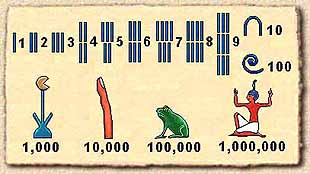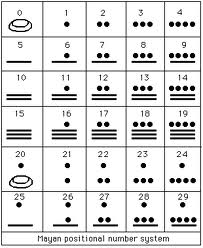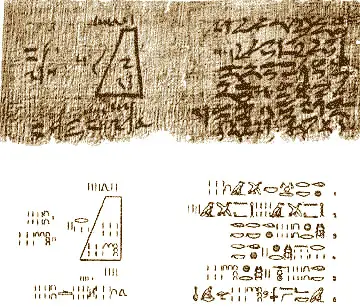 Ancient texts could be written either in hieroglyphs or in hieratic. Hieroglyphic script was developed at around 3000 BC. The earliest fully developed base 10 numeration system was used during 2700 BC. Precision surveying in the construction of the Great Pyramid of Giza built in 2650 BC shows a notable achievement in engineering.The two major texts on the mathematics of ancient Egypt were the Moscow Papyrus of 1800 BC and the Rhind Papyrus of 1650 BC. The former contains twenty-five problems while some ask for an equation. It also contains geometric problems.
Ancient texts could be written either in hieroglyphs or in hieratic. Hieroglyphic script was developed at around 3000 BC. The earliest fully developed base 10 numeration system was used during 2700 BC. Precision surveying in the construction of the Great Pyramid of Giza built in 2650 BC shows a notable achievement in engineering.The two major texts on the mathematics of ancient Egypt were the Moscow Papyrus of 1800 BC and the Rhind Papyrus of 1650 BC. The former contains twenty-five problems while some ask for an equation. It also contains geometric problems.Egyptian Mathematics

Egyptians used the lunary system of numbers. In this system, a simple line meant one; two lines meant two, three lines three and so on. When it reached 10, a new symbol like an inverted U was used.
Egyptian Number System
Egyptians knew addition, subtraction, some division, and multiplication. They also used unit fractions. The Egyptian Mathematical Leather Roll is a table of unit fractions which are expressed as sums of other unit fractions. However, Egyptian number system was not suitable for arithmetic calculations.
Egyptian Geometry

Geometry was essential for Egyptians as they constructed a number of structures including the pyramids. The Great Pyramid of Khufu from the Fourth Dynasty was a mathematical wonder because it was laid out with geometric precision.
The scribes recorded problems computing the areas of triangles, circles, and rectangles. The angle between the base and one of the faces is 51° 50′ 35″. The secant of this angle is 1.61806 which is remarkably close to the golden ratio 1.618034.
The Egyptians had a well-defined civil calendar containing 365 days. The beginning of the year was chosen as the heliacal rising of Sirius, the brightest star in the sky.
Eventually, the civil year was divided into 12 months, with a 5 day extra period at the end of the year. There were three seasons, each made up of four months. The months were divided into three weeks of ten days each.
Clocks were also used by the people of Egypt. Clocks were of two types; the sun clocks and the water clocks. Sun clocks were formed by means of the construction of Obelisks, tapering monuments. The clock worked much like a sundial, by watching the moving shadows throughout the day.
By doing this, the Egyptians were able to divide the day into morning, afternoon, and night. Water clocks were some of the earliest clocks used. Water Clocks were like pots made of stones, with long slanting sides that allowed water to drip down at a constant rate through a small hole in the bottom.